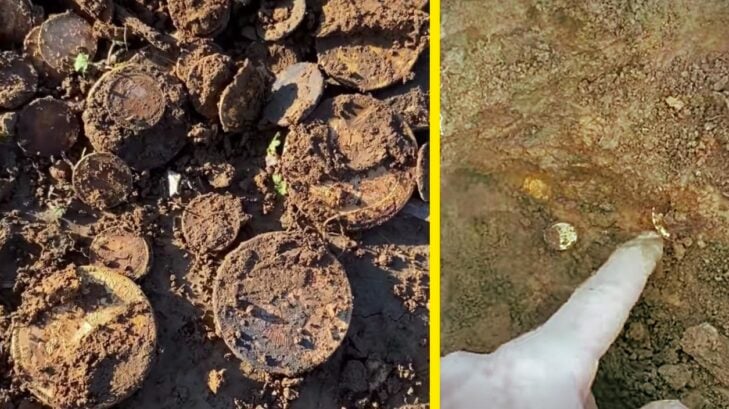In an extraordinary discovery that has sparked excitement among coin collectors and Civil War enthusiasts alike, a Kentucky farmer has unearthed a treasure trove of over 700 coins dating back to the American Civil War era, right in the heart of his cornfield.
This historic find, now known as the “Great Kentucky Hoard,” offers a captivating glimpse into an era rife with conflict and tumult.
How Did Kentucky Farmer Find The Gold Coins?
As this fortunate farmer tilled his land, hundreds of gold pieces, some dating as far back as 1840, tumbled out of the earth. His astonished reaction, captured in a short video, echoes the excitement felt by many.
According to the video posted to YouTube by GovMint.com Coins, the farmer can be heard saying, “This is the most insane thing ever: Those are all $1 gold coins, $20 gold coins, $10 gold coins.”
The Numismatic Guaranty Co. (NGC) and GovMint have confirmed the cache’s authenticity, revealing that the hoard comprises mostly of gold dollars, along with twenty $10 Liberty coins and eight rare $20 Liberty coins. The jewel in this historic crown is the 1863-P $20 1-ounce gold Liberty coin, of which there are 18 in this hoard.
A single specimen of this coin, minted after the 1848 California Gold Rush, can command six figures at auction. Notably, these Liberty coins predate the addition of “In God We Trust” on the coinage in 1866, making them rarer still.
Why Were The Coins Buried There?
The real significance of the Great Kentucky Hoard may lie in the historical insights it offers. Ryan McNutt, a conflict archaeologist at Georgia Southern University, suggests that these coins may have been buried in anticipation of Confederate John Hunt Morgan’s infamous raid in 1863.
It was common practice for wealthy Kentuckians to safeguard their wealth from Confederate pillage by burying it. While legends abound of such concealed treasures, no such cache had been recovered until now.

According to local tales, U.S. Infantry soldier, James Langstaff left behind a handwritten note asserting that a whopping $20,000 in coins had been discreetly buried on his vast estate located in Paducah. Similarly, it is said that William Pettit cunningly concealed a treasure trove of gold coins valued at around $80,000 in close proximity to Lexington.
Additionally, there are reports suggesting that Confederate soldiers, while under quarantine due to a measles outbreak, illicitly obtained payroll funds and stashed them away within a hidden cave situated in the Cumberland Gap region. Astonishingly, none of these hidden caches have ever been successfully retrieved throughout history.
Further, given that the hoard comprises federal currency, McNutt speculates that this might hint at clandestine financial dealings with the federal government—dealings best kept hidden from Confederate eyes. The Civil War era was rife with such subterfuge, with many Americans adept at hiding goods and valuables.
The Great Kentucky Hoard’s discovery on private land also raises the issue of archaeological consultation—a practice often overlooked in such situations, leading to a potential loss of valuable historical information. However, McNutt believes that education and outreach can encourage landowners to engage with archaeologists for a deeper understanding of these priceless historical caches.
The Great Kentucky Hoard, a snapshot of a turbulent past, has ignited the imagination of historians, archaeologists, and enthusiasts alike, serving not just as a treasure trove for coin collectors, but also as a fascinating window into the tumultuous times of the American Civil War.
RELATED: Dad Finds $10,000 & Silver Coins Inside Chest At Utah Canyon



